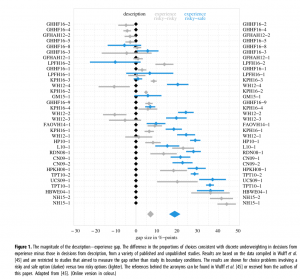Ralph Hertwig, Dirk Wulff, and I have a new paper out that identifies/summarizes three gaps that have emerged from recent work in economics and psychology on risk preference…

Three gaps and what they may mean for risk preference
Risk preference is one of the most important building blocks of choice theories in the behavioural sciences. In economics, it is often conceptualized as preferences concerning the variance of monetary payoffs, whereas in psychology, risk preference is often thought to capture the propensity to engage in behaviour with the potential for loss or harm. Both concepts are associated with distinct measurement traditions: economics has traditionally relied on behavioural measures, while psychology has often relied on self-reports. We review three important gaps that have emerged from work stemming from these two measurement traditions: first, a description– experience gap which suggests that behavioural measures do not speak with one voice and can give very different views on an individual’s appetite for risk; second, a behaviour–self-report gap which suggests that different self-report measures, but not behavioural measures, show a high degree of convergent validity; and, third, a temporal stability gap which suggests that self-reports, but not behavioural measures, show considerable temporal stability across periods of years. Risk preference, when measured through self-reports—but not behavioural tests—appears as a moderately stable psychological trait with both general and domain-specific components. We argue that future work needs to address the gaps that have emerged from the two measurement traditions and test their differential predictive validity for important economic, health and well-being outcomes.
Be the first to leave a comment. Don’t be shy.